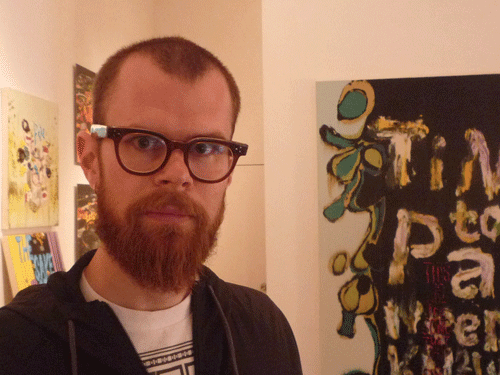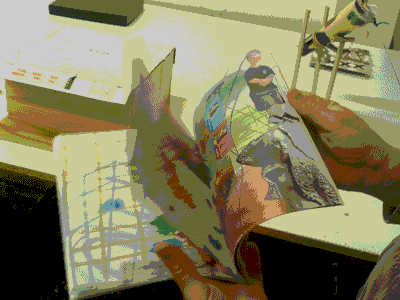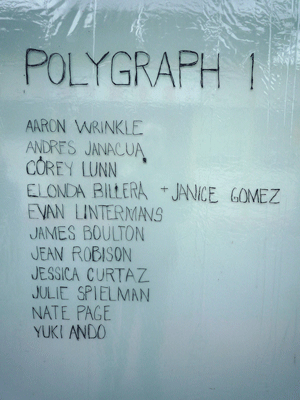April 12, 2010
Kris Chatterson, James Boulton

Kris Chatterson, proprietor of KCLOG (and excellent gallery review blog covering young exhibition spaces in Manhattan) dropped in for a visit while he as out from New York to attend a group show that he was included in at Western Projects (gallery) in Culver City. Titled Construction Zone 2010, it opened last week.
(The sculpture in steel -a representation of wood- in the foreground is from Jason Adkins)

Talking to Kris, it was interesting to get an small insight into his paintings in that he is actively using both the plasticity of paint and plasticity of image processing computer programs such as Photoshop. The use of optical equipment in the production of art is as old as the camera obscura, and as common as the presence of overhead projectors that are ubiquitous in artist studios here in Southern California. Kris has achieved a level of fluidity in the use of image processing programs that is worthy of note and it seems to me that his ambition is to merge the two worlds mentioned earlier; on one hand, painting, and on the other, state of the art (image/information manipulation) technology.
Conjoined hands.
His process involves a traditional entry into a painting in acrylic. Images either taken from the painting or imported elsewhere are worked up simultaneously in his computer. Some kind of printing technology tiles up the image from larger files into a mosaic of 8-1/2x11's. The trick is how to get it onto the surface of the painting. First, he flattens his image by overglazing with matt medium, several coats. Then he sands it flat, the medium preserving the state of the painting at this transition. He then adheres the image onto the canvas via some kind of acrylic transfer method (face down in acrylic gel or somesuch). I'm not sure if he repeats this cycle or not, but with a final sealing coat of glaze, the painting is done.
To what end? We talked about Vermeer and the Dutch light, of California Light and Space, and David Reed, and how he was painting from the light of cathode ray tubes. I wouldn't say that Kris Chatterson is painting with a regard for the light emitted from LCD arrays.. but I'd go out on a limb and guess that what he's doing involves the flash of electrons changing the state of bits from one to the other. In this way, I see his paintings flashing likewise.
After the visit, we dropped in next door to see a show that was being taken down...


My neighbor Evan Lintermans cleared out his studio to have a one night show.
John Boulton published a limited edition book, a collage of images, and handed our ten of them to ten friends and asked them to alter it as they pleased. the space was cleaned up, and a show installed in an afternoon. A barrel of beer and a night of bonhomie.

(I was a bit sloppy in shooting fotos, some artists aren't represented in the collage above.)
A polygraph? A lie detector? One administered to friends and acquaintances? Polygraph technology assumes a baseline of information and a series of questions designed to evoke a response or a lack of one. Information flows and characters revealed. Well, that's a fine premise for a group show, isn't it?
Posted by Dennis at April 12, 2010 5:09 PM
Leave a comment